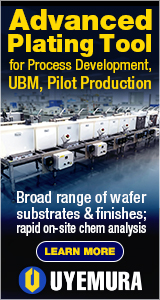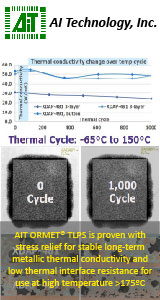|

|
|
| Ask the Experts | |||||||
|
|||||||
|
January 3, 2018 - Updated February 7, 2011 - Originally Posted Puzzling PCB Reflow Delamination ProblemWe baked our bare PCB's at 100 C for 6 hours and then dipped the PCB's in our HAL machine at 250 C for 10 seconds with no delamination problems. The same PCB's were assembled and passed through our wave soldering system at minimum conveyor speed with no delamination. Finally the same PCB's had SMT components placed and the PCB's passed through our reflow system at 217 - 230 C. Most of these PCB's had issues with delamination. Where should we look to solve this puzzling problem? K. L. R. |
|||||||
| Expert Panel Responses | |||||||
|
PCB delamination remains quite common, yet tricky, with a number of contributing root causes. Firstly, it is not clear why you are baking. Secondly, bake temperature should be above 100 deg C (boiling point of water), typically 105 deg C. WITH proper calibration of the oven. Also, make sure there is sufficient gap between PCBs during the bake period. This will ensure proper circulation, don't stack PCBs, not two high, not four high. You did not mention the location of the delamination. But, moisture can sometimes reside at features (such as PTHs or vias) with recessed resin, and pressure from this expanding moisture can cause internal delamination or cracks that do not extend to the outside. In severe cases, the vapor pressure induced stress can result in external cracks as well. Was there an extended uncontrolled storage period prior to assembly steps? Excessive flexure of the bare board during transportation, storage or handling can also create micro-pockets for the moisture to reside. Moisture trapped turns to steam which expands rapidly when the PCB is exposed to the high temperature.
Laboratory Director CALCE, University of Maryland Bhanu Sood is the Laboratory Director at the Center for Advanced Life Cycle Engineering (CALCE) and actively assists companies and organizations in all aspects of electronics reliability. Sood's key focus area is in design reviews, custom tests, and failure analysis services. He has authored several articles on board and component level reliability and unique failure mechanisms in electronics.
As per the description, the PCB had already been through several thermal excursions by getting baked, going through the HAL process at 250 Deg. C and then through the wave at approximately 260 + Deg. C, at minimum speed. Following this it also appears to be going through a lead-free reflow process (217-230 Deg. C). The first parameter to consider is whether this PCB is standard FR4 or high performance FR4. The high performance FR4 will be suitable for lead-free and multiple thermal excursions like the one indicated in the description, because it has higher Tg (glass transition temperature) than standard FR4.
President inspīre solutions LLC Bjorn Dahle is the President of inspīre solutions LLC. He has 20 years experience in the electronic manufacturing industry with various manufacturing equipment companies covering pick & place, screen printers and thermal process management.
I would suggest you look at the interval between each step and the storage conditions the PCBs were subject to in that period. How long were they set aside and were they exposed to high humidity or moisture in the form of condensation from a cooler in the factory for example. The other area to look into is the period at higher temperatures in Reflow compared to the Wave. It is possible the soak period in reflow is significantly longer than in wave and as a result is long enough to create a pressure issue with any residual trapped moisture.
CEO ATEK llc Allen Duck is a 20-year Electronics Industry veteran with Global experience in multiple fields of technology and management. He started A-Tek in 2006 to provide a sales and service channel for international equipment companies wishing to offer value based solutions to USA companies.
HAL is much less stressful than SMT. Problems with board lamination can show up in SMT and be fine in HAL.
CEO & Managing Partner DfR Solutions Dr. Hillman's specialties include best practices in Design for Reliability, strategies for transitioning to Pb-free, supplier qualification, passive component technology and printed board failure mechanisms.
First things first - the 100 C baking temperature willnot get the moisture out of your boards unless you use a vacuum chamber inorder to lower the boiling point of the water. Then you need to understand that the wave solder or yourdip process is limited to few seconds and your SMT reflow oven will have areflow temperature for 60 to 120 seconds - so more time for the water to try tocome out and so the delamination is more likely to occur there. The bottom line is that you have moisture in the boardsand I recommend you to focus on this - why the moisture gets in your PCBs andhow can you avoid that. For the PCBs in stock you will need a method to bake thatmoisture out - using a vacuum bake should fix the problem.
Engineering and Operations Management Independent Consultant Georgian Simion is an independent consultant with 20+ years in electronics manufacturing engineering and operations.
Contact me at georgiansimion@yahoo.com. Reader Comment
I agree with most comments. Mr. Bhanu Sood's point is very valid.There are many reasons for the delamination of assembled PCBs. The main culprit is moisture entrapped, not fully removable by any of the bake and other methods. It is important to choose a High Tg laminate followed by process controls at various stages in bare PCB manufacturing followed by good assembly practices and ensuring that the humidity and moisture entrapment is minimal to have a final non delaminated assembled board.
Ranganath Mandayam, TQM Consultancy
|
|||||||
| Submit A Comment | |||||||
|
Comments are reviewed prior to posting. You must include your full name to have your comments posted. We will not post your email address. |
|
Free Newsletter Subscription
Circuitnet is built for professionals who bear the responsibility of looking ahead, imagining the future, and preparing for it. Insert Your Email Address |
|

|







